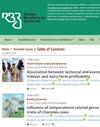巴西蜂王浆生产的水平和垂直菌落
IF 1.2
4区 农林科学
Q3 Agricultural and Biological Sciences
Revista Brasileira De Zootecnia-Brazilian Journal of Animal Science
Pub Date : 2022-01-01
DOI:10.37496/rbz5120210043
引用次数: 1
摘要
- 2019年春季,利用水平和垂直系统中每个蜂群两个蜂王的技术,评估了非洲化蜂群中蜂王浆生产的潜力。测试了这些技术对细胞接受度的影响(%);在巴西南部,蜂王浆的每菌落产量(g)、每次收获量(g)和每个细胞条位置(g),并与标准技术(五帧和十帧蜂箱)进行比较。结果表明,两种方法的蜂王浆产量具有统计学意义。垂直蜂群的蜂王浆产生量(8.26和53.28±4.98 g)显著高于单蜂群在十框蜂箱中的产生量(4.30和32.76±3.57 g)和五框蜂箱重叠的产生量(2.03和14.45±2.48 g),但与双蜂王水平蜂群的产生量(8.09和46.81±4.90 g)差异不显著,而在垂直、水平和十框蜂群中,蜂王细胞接受率无显著差异。与标准蜂群相比,双蜂王垂直蜂群蜂王浆产量增加。本文章由计算机程序翻译,如有差异,请以英文原文为准。
Horizontal and vertical colonies for royal jelly production in Brazil
- The potential of royal jelly production in Africanized honeybee colonies was evaluated using techniques involving two queens per colony in horizontal and vertical systems during the spring of 2019. The techniques were tested for their effect on cell acceptance (%); royal jelly production per colony (g), per harvest (g), and per position of cell bar (g) and compared with standard techniques (five and ten-frame hives) in southern Brazil. Results showed statistical significance in royal jelly production between methods. Vertical colonies produced a significantly greater amount of royal jelly per colony and per harvest (8.26 and 53.28±4.98 g) compared with single-queen colonies in ten-frame hives (4.30 and 32.76±3.57 g) and five-frame hives overlapping (2.03 and 14.45±2.48 g), but did not differ from two-queen horizontal colonies (8.09 and 46.81±4.90 g). In contrast, there was no significant difference in queen cell acceptance rate within vertical, horizontal, and ten-frame colonies. Royal jelly yield of two-queen vertical colonies increase as compared with standard colonies.
求助全文
通过发布文献求助,成功后即可免费获取论文全文。
去求助
来源期刊
CiteScore
1.90
自引率
0.00%
发文量
25
审稿时长
8 weeks
期刊介绍:
The Revista Brasileira de Zootecnia (RBZ; Brazilian Journal of Animal Science) encompasses all fields of Animal Science Research. The RBZ publishes original scientific articles in the areas of Aquaculture, Biometeorology and Animal Welfare, Forage Crops and Grasslands, Animal and Forage Plants Breeding and Genetics, Animal Reproduction, Ruminant and Non-Ruminant Nutrition, and Animal Production Systems and Agribusiness.

 求助内容:
求助内容: 应助结果提醒方式:
应助结果提醒方式:


